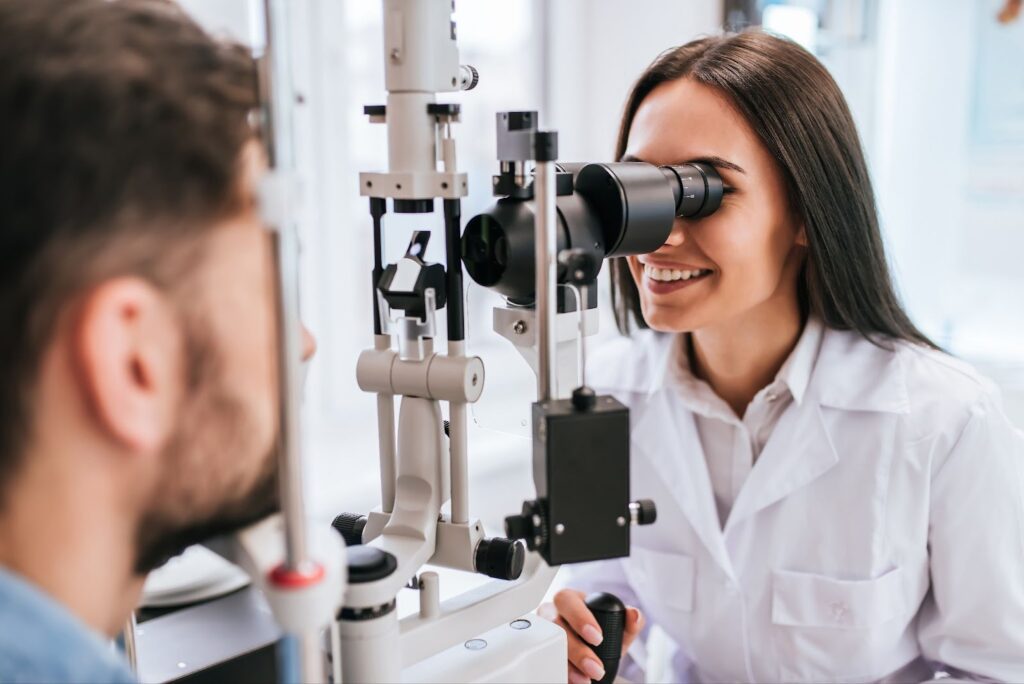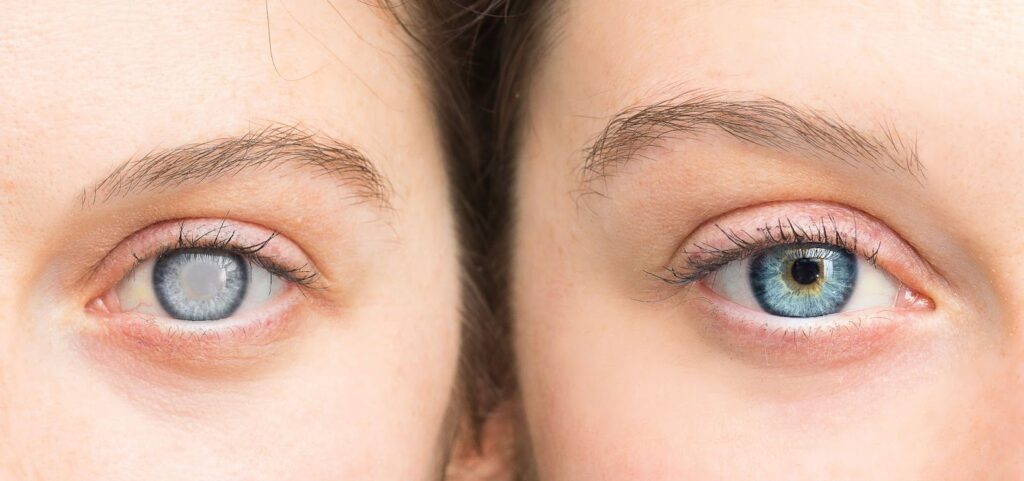If you’ve noticed any changes in your vision, like blurriness or issues with color clarity, you may be dealing with an eye condition like cataracts or glaucoma. These conditions are 2 of the leading causes of vision loss, making it crucial to learn to recognize the signs of each. So how do you tell if you have cataracts or glaucoma?
Cataracts develop when the lens of your eye becomes cloudy, causing blurry vision and difficulty seeing at night. It’s a common condition that can affect anyone and usually develops due to age. On the other hand, glaucoma is a group of eye diseases that damage the optic nerve, leading to gradual vision loss. So while cataracts primarily affect THE LENS OF YOUR EYE, glaucoma affects your optic nerve.
What Are Cataracts?
Inside your eye, you have a small, clear natural lens. It’s just like the lens of a camera—it bends light as it enters to focus on a single point at the back of your eye. This lens is like the entryway to your visual system.
However, over time, this lens can begin to cloud over. This starts to obstruct light as it enters the eye, leading to issues with your vision. Whether due to an injury, medical condition, or normal age-related changes in the eye, this eye condition is not uncommon. It’s called a cataract.
The Symptoms of Cataracts
As the lens begins to cloud, you’ll likely notice the following symptoms:
- Cloudy or blurry vision
- Colors appear faded
- Glare, particularly at night
- Frequent changes in eyeglass or contact lens prescriptions
- Double vision in a single eye
If these symptoms sound familiar, it’s time to reach out to your optometrist.
Are Cataracts Treatable?
Cataracts are extremely common—in fact, it’s estimated that at least 50% of the population will deal with these at some point in their life. But there’s good news! They’re also highly treatable.
When you’ve been diagnosed with cataracts, your optometrist will likely recommend cataract surgery when they have affected your vision to worse than 20/30. This is a simple surgery that replaces the now-cloudy lens with an artificial intraocular lens, or IOL, to restore your vision.
This new lens acts and feels just like your natural lens. It helps your eye refract light properly again to keep your vision clear and get rid of those irritating cataract symptoms.
What Is Glaucoma?
Your eye is a complex organ. Fluid enters, bringing with it all kinds of nutrients and compounds that keep your eye healthy. This fluid eventually leaves through your eye’s natural drainage system—this helps prevent too much pressure inside. This entire system helps you maintain a healthy eye.
But what if this fluid doesn’t exit properly? The pressure would build, and this can slowly begin damaging your eye and the surrounding systems. If this is the case, you’re dealing with glaucoma.
This is a group of eye diseases that eventually damage the optic nerve due to internal pressure. Glaucoma is a complicated and subtle condition, often progressing without any obvious symptoms. If it’s left untreated, it can lead to permanent optic nerve damage affecting the sensitivity of your peripheral vision first, then continuing to tunnel vision loss.
This is why it’s so essential to regularly get checked for glaucoma. Catching this condition early is significantly easier than treating it!
The Different Types of Glaucoma
There are 4 primary types of glaucoma:
- Open-angle glaucoma, the most common form, which develops gradually due to clogs or blockages in the eye’s natural drainage canal.
- Angle-closure glaucoma, where the iris itself restricts or completely blocks the natural drainage canal.
- Congenital glaucoma, which is present at birth due to a developmental issue
- Secondary glaucoma, which can develop as a complication due to other medical conditions
Unlike cataracts, glaucoma doesn’t showcase any obvious symptoms in the earliest stages. This is why regular eye exams are such a crucial part of maintaining your health! Your optometrist can examine your eye’s physical structures, check your intraocular pressure and sensitivity of your peripheral vision to determine whether or not you’re at risk of glaucoma.

When to Visit Your Optometrist
Cataracts and glaucoma are two separate conditions. However, they aren’t the only eye conditions out there. Your vision is precious, so it’s essential to learn to realize that something isn’t quite right.
If you experience any of the following symptoms, visit your optometrist as soon as you can:
- Sudden vision changes
- Eye pain
- Halos around lights
- Redness in the eye
- Nausea or vomiting associated with eye pain
These are all signs that something serious is going on, and it’s time to let a professional intervene.
Get Your Eyes Checked
Don’t wait until vision problems interfere with your daily life. Instead, come talk to our team at The Vision Place! We’re here to help take care of your eyes and maintain your vision for years to come. Take control of your eye health today, and book an appointment with us!


